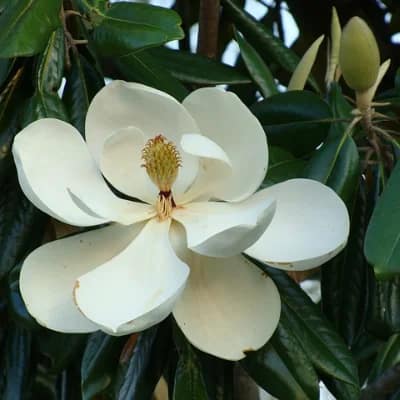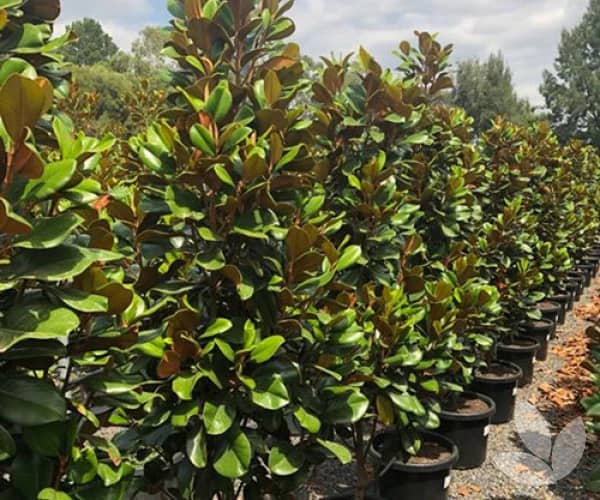Teddy bear magnolia trees are a popular choice for many garden lovers. Known for their compact size and beautiful, glossy leaves, these trees bring a touch of elegance to any landscape. Whether you’re considering planting one or already have one in your garden, this article will guide you through the essentials.
Teddy Bear Magnolia Tree vs Little Gem
When comparing the teddy bear magnolia tree vs little gem, the key difference lies in their size and growth habits. The teddy bear magnolia tree tends to be more compact and denser, making it ideal for smaller spaces. In contrast, the Little Gem magnolia grows taller and can spread wider, which might require more room in your garden. Both have similar care requirements, but the magnolia teddy bear tree is perfect for those who want a more manageable size without compromising on beauty.
KNOW MORE ABOUT MAGNOLIA TREES CLICK HERE : Everything You Need to Know About Magnolia Trees in Your Garden
What to Expect from a Full Grown Teddy Bear Magnolia Tree
A full grown teddy bear magnolia tree typically reaches a height of about 16 to 20 feet and a width of 8 to 10 feet. This makes it a wonderful choice for both small and large gardens. The dense foliage and large, fragrant white flowers are the main attractions of the magnolia tree teddy bear.
How to Plant a Teddy Bear Magnolia Tree
If you’re wondering how to plant a teddy bear magnolia tree, it’s important to choose the right spot. These trees prefer well-drained soil and full sun to partial shade. To plant, dig a hole twice as wide as the root ball but no deeper. Place the tree in the hole, backfill with soil, and water thoroughly. Adding a layer of mulch around the base will help retain moisture.
How to Prune a Teddy Bear Magnolia Tree
Knowing how to prune a teddy bear magnolia tree is crucial for maintaining its shape and health. The best time to prune is late winter or early spring before new growth begins. Start by removing any dead or damaged branches. Next, thin out overcrowded areas to allow light and air to reach the center of the tree. Always use clean, sharp tools to make clean cuts, which will help the tree heal quickly.
How Fast Do Teddy Bear Magnolia Trees Grow?
A common question is, how fast do teddy bear magnolia trees grow? These trees have a moderate growth rate, typically growing about 1 to 2 feet per year. With proper care, you can expect your magnolia teddy bear tree to reach its full size in several years, making it a manageable addition to any garden.
Why Does My Teddy Bear Magnolia Tree Not Flower?
If you’re asking, why does my teddy bear magnolia tree not flower, there could be several reasons. Insufficient sunlight, poor soil conditions, or improper pruning can all affect flowering. Ensure your tree is getting enough light and nutrients. Avoid heavy pruning, as it can remove the buds that would develop into flowers. Patience is also key, as younger trees may take a few years before they start blooming profusely.

Growing and Caring for Teddy Bear Magnolia Trees
Teddy bear magnolia trees are not only known for their compact size and attractive foliage but also for their ability to adapt to various garden settings. Whether you’re a seasoned gardener or a beginner, these trees offer a low-maintenance option that brings year-round beauty to your landscape.
Ideal Growing Conditions for Teddy Bear Magnolia Trees
To ensure your magnolia teddy bear tree thrives, it’s important to provide the right growing conditions. These trees prefer:
- Sunlight: Full sun to partial shade is ideal. Aim for at least 6 hours of direct sunlight per day to encourage healthy growth and flowering.
- Soil: Well-drained, slightly acidic soil is best. If your soil is heavy clay or overly sandy, consider amending it with organic matter to improve drainage and fertility.
- Watering: Teddy bear magnolia trees require regular watering, especially during their first few years of establishment. Keep the soil consistently moist but not waterlogged.
Fertilizing Your Teddy Bear Magnolia Tree
Fertilizing is another important aspect of caring for your magnolia tree teddy bear. In the spring, apply a balanced, slow-release fertilizer to promote growth and flowering. Avoid over-fertilizing, as this can lead to excessive leaf growth at the expense of flowers.
How to Prevent Pests and Diseases
While teddy bear magnolia trees are relatively resistant to pests and diseases, it’s still important to keep an eye out for common issues. Scale insects and aphids can occasionally be a problem, as well as fungal diseases like leaf spot. Regularly inspect your tree for signs of trouble, and treat any issues promptly with appropriate organic or chemical controls.
How to Address Common Issues with Teddy Bear Magnolia Trees
In addition to understanding how to plant a teddy bear magnolia tree, it’s helpful to know how to address common problems that may arise:
- Leaf Discoloration: If the leaves of your magnolia teddy bear tree start to yellow, it could be a sign of overwatering, poor drainage, or nutrient deficiency. Adjust your watering habits and consider a soil test to determine if additional nutrients are needed.
- Wilting or Drooping Leaves: This could indicate root rot or insufficient watering. Check the moisture levels in the soil and ensure the tree is not sitting in waterlogged conditions.
- Lack of Blooms: If your tree is not flowering as expected, review your pruning practices, ensure adequate sunlight, and consider the age of the tree. It may simply need more time to mature before blooming fully.
Landscaping Ideas with Teddy Bear Magnolia Trees
Teddy bear magnolia trees are versatile and can be used in various landscaping designs. Their compact size makes them perfect for:
- Privacy Screens: Plant several teddy bear magnolia trees in a row to create a dense, evergreen screen that offers privacy without taking up too much space.
- Specimen Trees: Use a single magnolia teddy bear tree as a focal point in a small garden or courtyard. Its glossy leaves and large, fragrant flowers will draw attention and add visual interest.
- Container Planting: For those with limited space, these trees can be grown in large containers. Just be sure to provide ample water and nutrients, as container-grown trees can dry out more quickly than those planted in the ground.
The Charm of Teddy Bear Magnolia Trees in All Seasons
One of the most appealing features of the magnolia teddy bear tree is its year-round beauty. In spring and summer, you’ll enjoy the stunning white flowers that contrast beautifully with the dark green leaves. In fall, the leaves may take on a bronze hue, adding warmth to your garden. Even in winter, the dense foliage provides structure and color when many other plants have gone dormant.
The Aesthetic Appeal of Teddy Bear Magnolia Trees
Teddy bear magnolia trees are prized not just for their compact size and easy care, but also for their stunning aesthetic appeal. The leaves are glossy and dark green, creating a lush backdrop for the large, fragrant white flowers that bloom in the warmer months. These flowers are a showstopper, often reaching up to 8 inches in diameter, and they fill the air with a delightful fragrance that can transform your garden into a peaceful retreat.
Designing with Teddy Bear Magnolia Trees
When incorporating teddy bear magnolia trees into your garden design, consider their full-grown size and growth habits. Their compact form makes them ideal for smaller spaces, but they can also be grouped together in larger landscapes for a more dramatic effect. Here are some design ideas:
- Foundation Planting: Magnolia teddy bear trees are excellent choices for foundation planting around your home. Their upright, dense growth habit provides year-round greenery and softens the lines of your home’s exterior.
- Mixed Borders: Combine teddy bear magnolia trees with other evergreen shrubs and perennials to create a dynamic and varied border. Their large flowers can serve as a focal point among other plantings.
- Urban Gardens: If you live in an urban environment with limited space, the magnolia tree teddy bear is perfect for adding a touch of nature without overwhelming your garden. Its moderate growth rate and manageable size make it well-suited for small urban gardens or even rooftop settings.
KNOW MORE ABOUT LITTLE GEM MAGNOLIA TREE CLICK HERE : Little Gem Magnolia Tree
How Fast Do Teddy Bear Magnolia Trees Grow?
Understanding the growth rate of teddy bear magnolia trees can help you plan your garden more effectively. These trees typically grow at a moderate pace, adding about 1 to 2 feet of height per year under optimal conditions. This steady growth means you won’t have to worry about them outgrowing their space too quickly, making them a reliable choice for long-term landscape planning.
Troubleshooting Common Issues with Teddy Bear Magnolia Trees
Even though teddy bear magnolia trees are generally easy to care for, you may encounter some challenges as you grow them. Here are a few common issues and how to address them:
- Pest Infestations: While generally resistant to pests, teddy bear magnolia trees can occasionally suffer from infestations of scale insects or aphids. These pests can be controlled with horticultural oil or insecticidal soap. Regular inspection and prompt action can prevent serious damage.
- Flowering Problems: If your magnolia tree teddy bear isn’t flowering, it may be due to a lack of sunlight, improper pruning, or simply that the tree is too young. Ensure the tree is planted in a sunny location and avoid heavy pruning that could remove flower buds.
- Soil and Water Issues: Poor soil conditions or incorrect watering practices can lead to yellowing leaves or stunted growth. Conduct a soil test to ensure the right pH and nutrient levels, and adjust your watering practices to maintain consistent moisture.
Seasonal Care for Teddy Bear Magnolia Trees
Caring for your magnolia teddy bear tree throughout the year involves some seasonal considerations:
- Spring: This is the best time to fertilize and prune your tree. Apply a slow-release fertilizer to promote new growth and flowers. Prune lightly to shape the tree and remove any dead or damaged branches.
- Summer: Ensure the tree is well-watered, especially during dry spells. Mulching around the base can help retain moisture and regulate soil temperature.
- Fall: As the growing season winds down, reduce watering slightly but continue to monitor soil moisture. This is also a good time to add a layer of mulch to protect the roots from winter cold.
- Winter: Teddy bear magnolia trees are evergreen, so they retain their leaves through the winter. However, in colder climates, you may want to protect the tree from harsh winds and freezing temperatures with a windbreak or burlap wrap.
Why Does My Teddy Bear Magnolia Tree Not Flower?
If you find yourself asking, why does my teddy bear magnolia tree not flower, it’s important to consider several factors:
- Age of the Tree: Younger trees may take a few years before they begin to flower. Patience is key as the tree matures.
- Sunlight: Ensure the tree is receiving adequate sunlight. Too much shade can reduce flower production.
- Pruning Practices: Improper pruning, especially in late summer or fall, can remove the buds that would have developed into flowers. Be cautious about when and how much you prune.
The Long-Term Beauty of Teddy Bear Magnolia Trees
The long-term beauty of teddy bear magnolia trees lies in their ability to maintain their form and foliage with minimal effort. Their slow to moderate growth rate ensures that they will remain a manageable size, while their dense foliage provides a year-round backdrop of lush greenery. Over time, these trees will become a cherished part of your garden, offering beauty and fragrance with each passing season.

